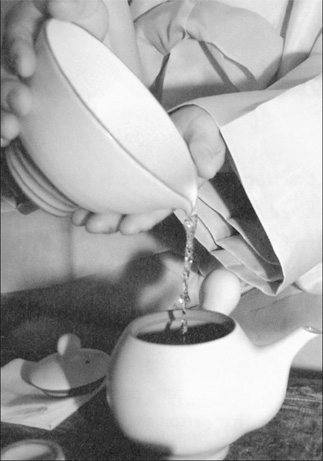Delicate springtime leaves tasting of starlight and dew

The Korean Way of Tea
The historian Stephen Ambrose, in his marvellous book “D-Day ― June 6 1944,” reports that British soldiers fought with characteristic grit during the Normandy landings and took Sword Beach from the Nazis. However, some American soldiers, arriving in the second wave, were surprised to find the beach head clogged, with traffic at a standstill.
An officer was dispatched to solve the problem. He found the British soldiers from the first wave clustered around their field stoves ― they had stopped the advance to take a tea break.
Brother Anthony of Taize was born in England two years before the D-Day landings. He has lived in Korea since 1980 and his in-bred passion for tea has been deepened by his contact with Korea’s extensive tea culture.
The result is his partnership with Hong Kyeong-hee, a tea scholar. Together they have written “The Korean Way of Tea.” The book is charming, full of interesting anecdotes and beautiful pictures. There are also extracts from poetry that suggest tea is of fundamental importance to the Korean soul.
A good example is Cho Ui’s “Dongdasong,” in which he writes “When tea’s blue waves and green fragrance enter the court of the heart, intelligence and brightness reach everywhere unimpeded, then your spiritual roots will rest on divine mountains.”
I can’t say I have ever felt that way after a morning cuppa, but then I learned from this book that I have been making tea like an amateur.
The first lesson I had to learn is that tea is not just a beverage but a form of spirituality. There’s heaven in those leaves for anybody who knows how to treat them in the right way.
The authors emphasize this in a section called “The Virtues of Tea” in which they write, “The Way of Tea is nothing less than a spiritual, religious activity leading to higher levels of inner awakening, if not inner enlightenment.”
At the beginning of the book Hong and Brother Anthony observe that there is a world of difference between the tea bags found at the supermarket and leaf tea sold in small quantities at specialty stores.
The cost of leaf tea is a function of several variables with each one a factor in pushing the price of the best varieties to astronomical levels.
First, there is the method that must used to ensure the leaves themselves are the best quality, suitable for spiritual uplift. This depends on the season.
Ujeon is tea harvested in April and it consists of the smallest, earliest shoots and it is always the most expensive. Sejak is tea made in late April or early May and Jungjak is made from leaves picked in late May.
Once the tea leaves have been picked, they must be dried the following day. “They are usually left to spend the night uncovered in the open air, piled loosely,” write the authors. “There is a belief that the final taste will be better if the leaves absorb the moonlight and starlight, and also the dew.”
After the leaves have been processed they are still a long way from being ready to drink.
“Nothing is more challenging than to make tea by hand,” write Hong and Brother Anthony. “Much of the finest tea is made by devoted monks who regard the task as a spiritual discipline requiring great concentration.”
Such efforts are necessary because the best leaves are so delicate. Those processing the leaves should, according to this book, have hands free from perfumed soap or cosmetics and possess “real cleanliness, simplicity of mind and devotion of heart.” Actually that’s a good prescription for writers as well. Maybe that’s why so many Korean authors have produced poems about tea and are experts in its rituals.
“The Korean Way of Tea” has no time for “teas” made from herbs. This book is exclusively about the beverage made from the leaves of camelia sinensis. This single-mindedness is laudable.
The result is a wealth of detail including a 12- page section that describes the equipment and spiritual attitude required to perform a tea ceremony. This has invaluable snippets, such as the need to place the leaves in the pot first during winter but to add water first during other seasons.
And once you have your cup, held in both hands, be sure to savor the sensations of tea which, according to Tang Dynasty poet Lu Tung, “lead to the Isle of Immortality.”
Brother Anthony of Taize and Hong Kyeong-Hee
Genre: Lifestyle
Publisher: Seoul Selection
By Daniel Jeffreys Deputy Editor [danielj@joongang.co.kr]










with the Korea JoongAng Daily
To write comments, please log in to one of the accounts.
Standards Board Policy (0/250자)